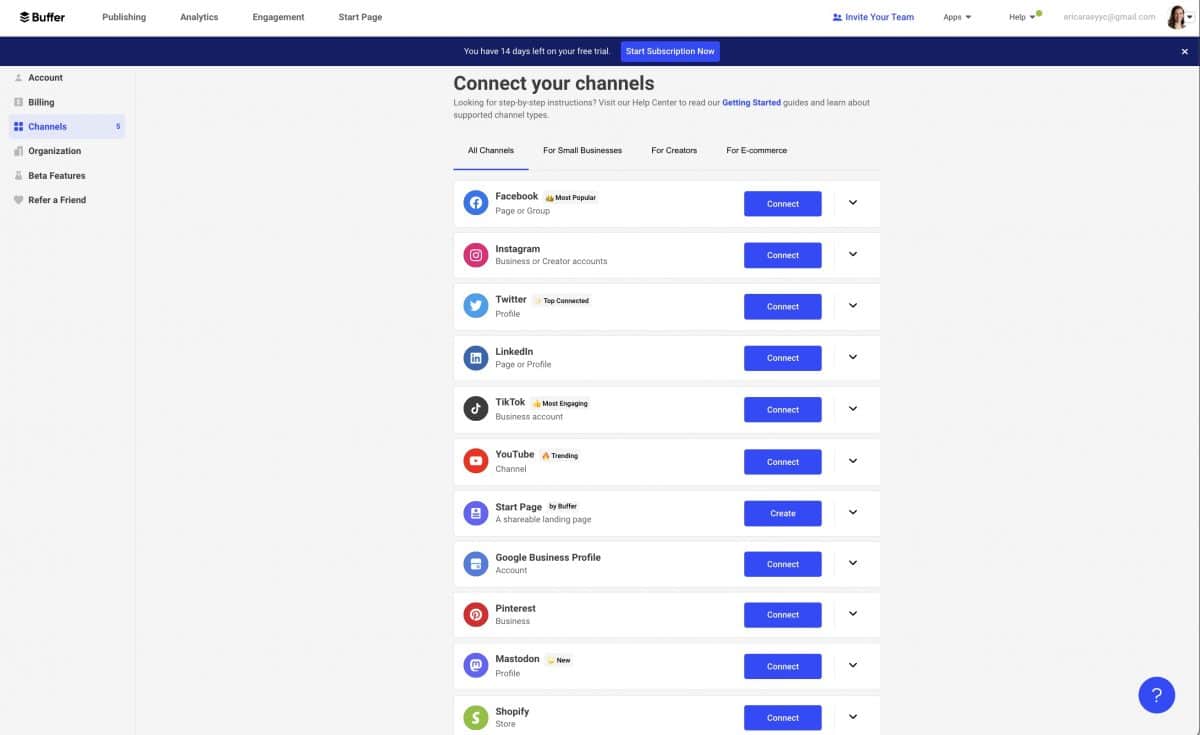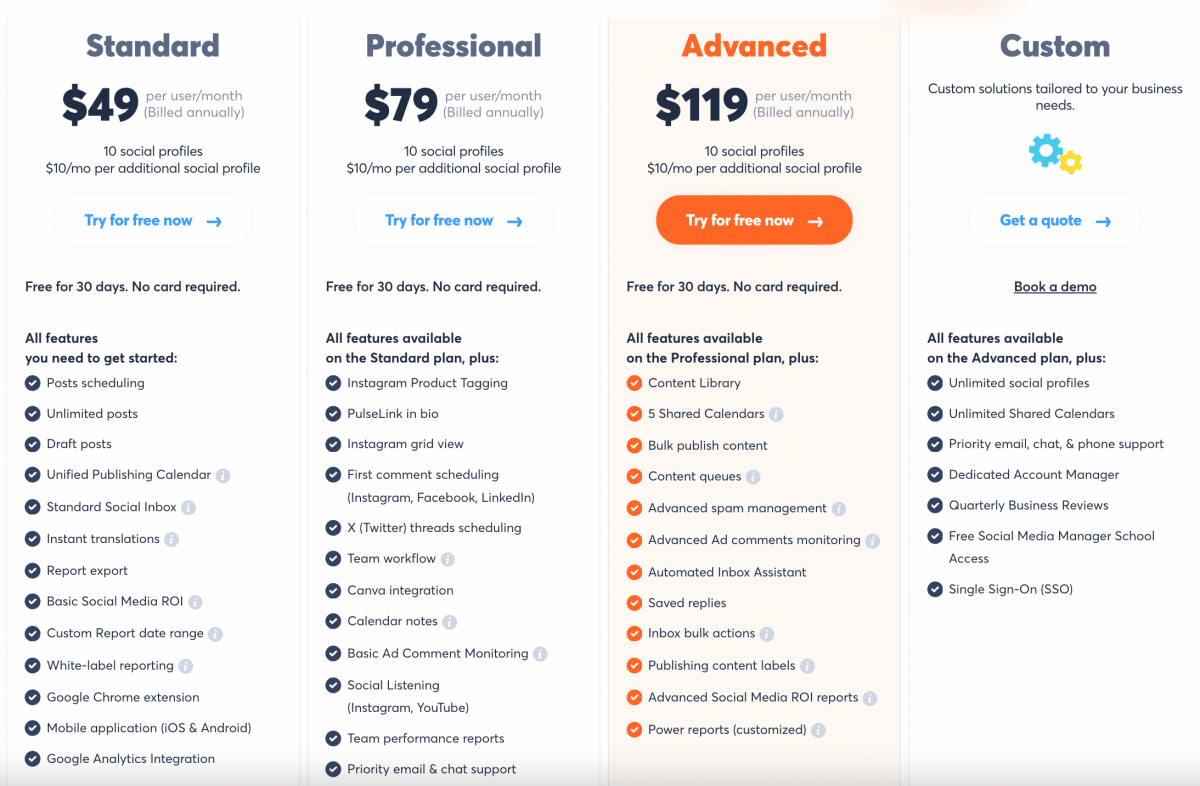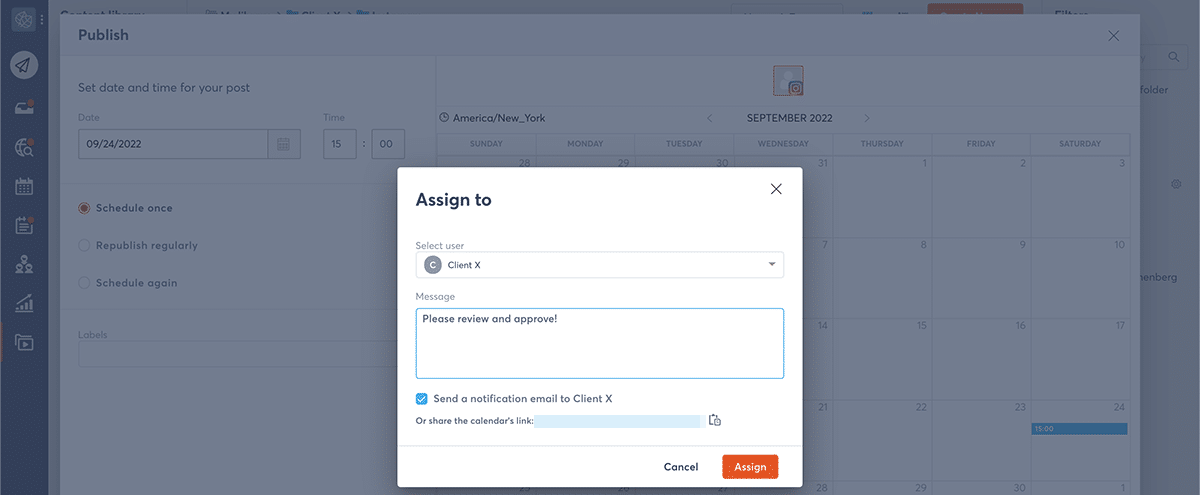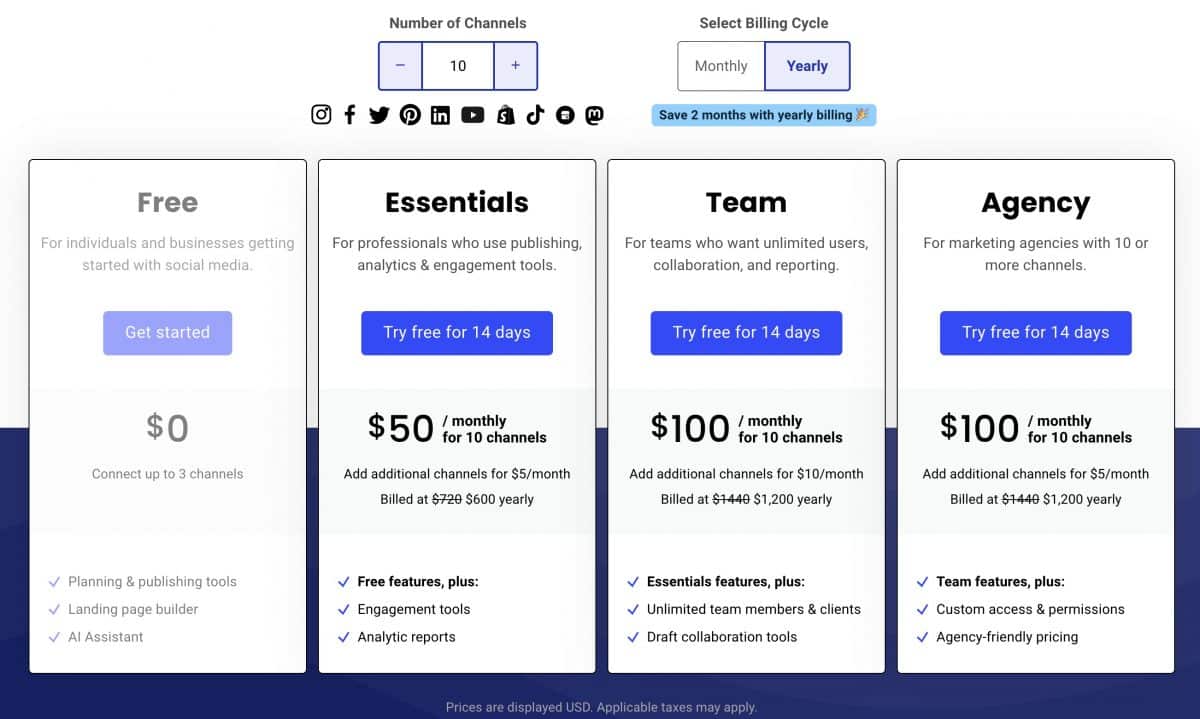If you’re here, you most likely want to know how Buffer pricing stacks up to some of the alternatives available. After all, when you choose your social media management tool, you want to make sure you get the best bang for your buck. If that’s the case, you’ve come to the right place.
We’ve got all the details on Buffer pricing. In this blog post, we’ll dig into the features included with each Buffer pricing plan and share the pros and cons of the Buffer pricing overall.
TL;DR
Here’s a very high-level summary:
- Four different plans with four price tags. You can pick and choose from various plans, but you’re going to miss out on some vital features, especially if you’re an agency.
- Flexibility. Buffer’s pricing is very flexible. If you don’t have to connect three or more social media channels, you might find it cost-friendly.
- Price tag expands considerably as your needs grow. Once you need to connect three or more channels, the flexibility ends up being far more costly.
- Not enough advanced features for agencies. You won’t get everything you, as an agency, need from a limited social media management tool like Buffer.
So, without further ado, let’s discuss the real cost of Buffer.
1. Buffer Pricing Breakdown
First, let’s go over the different pricing options available with Buffer.
Buffer has four plans available at four different price points:
Free plan
This one is fairly self-explanatory. In case it’s not obvious, this plan is free, as in $0 a month. You can connect up to three social channels on Buffer’s free plan.
Essentials plan
This plan is $5/month per social channel when paid annually. Or $6/month per channel when paying monthly. It includes only one user. If you want to add more users, you need to move up to the Team plan.
This plan does include a lot of great features, such as a link shortener tool, landing page builder, basic post analytics, and the ability to schedule Twitter threads.
However, there aren’t any approval workflow features on this plan. So, if you are working with a team of people, you’ll definitely want approval workflow features. No one wants the new intern to have the power to publish without approval.
Doing so can lead to all sorts of bad things, like accidentally publishing placeholder text or tweeting something that is factually incorrect. Or worse: Insensitive and offensive jokes can cause a social media backlash.
You certainly don’t want a social media crisis like Burger King tweeting, “Women belong in the kitchen.” (That actually happened.) So, if you think you can skip the approval workflows, think again.
Team plan
Next up is Buffer’s Team Plan, which is going to run you $10/month per social channel if you pay annually. Otherwise, the price is $12/month per social channel.
One thing that is nice about Buffer’s Team Plan is that you can add unlimited users without any additional charge. You also have the ability to add extra channels for $10/month.
Agency plan
The Buffer agency plan is (clearly) built for marketing agencies. The pricing reflects this, as it will cost you $100/month for 10 channels when paid annually.
Extra channels can be added for just $5 a month rather than $10 a month. If paid monthly, the price is $120/month, and additional channels can be added for $6. So if you are an agency managing many accounts, this might seem like a great deal at first glance. But the question you need to ask yourself is: Is this really a good value?
2. Buffer Pricing: The Good News
So here’s the good news about Buffer’s pricing: It is flexible.
With Buffer, you will only pay for the number of social accounts you need to connect. If you are new to social media marketing or perhaps are a smaller business that only needs to connect one or two accounts, you can potentially save a couple bucks on that monthly cost. You won’t end up paying for extra accounts that you don’t need.
What’s also unique with Buffer is that you have the option to connect to less mainstream social networks like Mastodon, or you can even connect to your Shopify store.

Connect your channels on Buffer.
These aren’t options that are offered on very many social media management tools. If you are looking to publish to either of those, Buffer may be the right tool for you.
Try Agorapulse for free!
Now, that being said …
3. Buffer Pricing: The Not-So-Good News
If you aren’t new to social media and you are going to connect 3 or more social channels, things start to not look so great.
For starters, let’s take a look at the Essentials Plan for Buffer, and compare it with the Standard Plan offered by Agorapulse.
Although Buffer’s plan seems “cheaper” on the surface, when you look a bit closer, you see that Buffer does not include nearly as many features as you get with Agorapulse. If you are going to be adding 10 social accounts or more, the monthly cost difference between Buffer and Agorapulse is negligible.
Here’s how it breaks down: Agorapulse’s Standard Plan is priced at $49/month, which at first glance may seem pricier. But when you look at what is included, this plan allows you to connect up to 10 social accounts.
If you wanted to add 10 accounts to Buffer’s Essentials plan, you’d be paying $50/month, so Agorapulse would actually be $1 cheaper.
Here’s the breakdown of Buffer pricing if you were connecting 10 social channels and paying annually.The Standard Plan offered by Agorapulse also includes more features than the Buffer Essential plan, such as the white-label reporting and social media inbox.

Agorapulse’s plans and pricing
But that’s not the only reason you may want to consider an alternative like Agorapulse. Check out the pricing more closely if you want details.
Sign up for a FREE trial of Agorapulse!
3. Buffer Pricing: The Deal Breakers
Here are the biggest deal breakers in regard to Buffer pricing.
Bottom line: There simply aren’t enough advanced features for agencies. Yes, Buffer has a plan that is specific to agencies. And yes, they do offer a slight price cut on the cost per account once you are on the Agency Plan.
But even on the Agency plan, you are still missing out on things that you really are going to need to have for working with your agency clients.
For example, social listening: Buffer doesn’t have it. Like, not at all. Agorapulse includes social listening features on its Professional Plan, which is just $79/month, including 10 channels.
What’s worse is that there are no shared calendar features available on Buffer either, which is a favorite of Agorapulse’s agency customers.

The shared calendar feature in Agorapulse is incredibly useful for getting fast and easy client approvals on your social posts.
Finally, Buffer’s social media inbox is disappointing. It only includes Facebook and Instagram. Also, it doesn’t have many helpful features that you might be looking for, such as saved replies.
(They used to have a much more advanced social media inbox called Buffer Reply. Oddly enough, this feature was discontinued back in 2020 and hasn’t been replaced by something that is as equally capable.)
If you want to see comments or messages for your other accounts like Twitter (now known as X) or TikTok, you must log into the actual social platform. That defeats the whole purpose of a social media inbox.
You are not going to save any time with Buffer especially if you still need to log into each individual platform to respond to any messages or comments on your posts.
With Agorapulse, you have the ability to see comments and DMs on all your social channels in the same feed, which is a huge time saver for agencies managing dozens of accounts.
In Conclusion
We could go on and on here, but you get the idea. Buffer is useful … unless you’re an agency, or you don’t require social listening, or you only want to connect a few accounts. Otherwise, you may want to look into a social media management tool that offers you more and will save you so much time.
Maybe try something like Agorapulse. Check out Agorapulse for free and see why it’s a favorite, especially among agencies.







